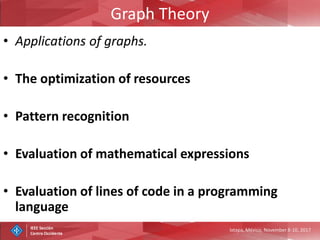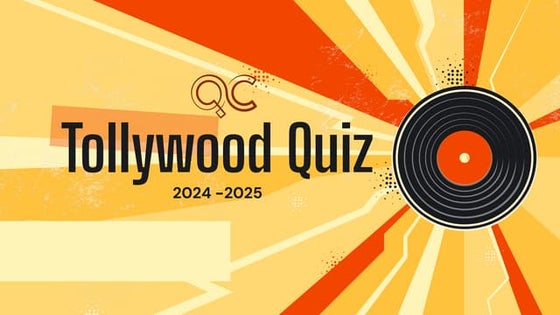The teaching-learning of Graph Theory with the support of Learn Graph-Ware software
- 1. Ixtapa, M├®xico, November 8-10, 2017 ŌĆ£The teaching-learning of Graph Theory with the support of Learn Graph-Ware softwareŌĆØ Jos├® Alfredo Jim├®nez-Murillo, Er├®ndira Miriam Jim├®nez-Hern├Īndez, Octavio Ort├Łz-Ort├Łz, Juan Carlos Olivares-Rojas and Paola Jim├®nez-Hern├Īndez
- 2. Ixtapa, M├®xico, November 8-10, 2017Ixtapa, M├®xico, November 8-10, 2017 Outline ŌĆó Introduction ŌĆó Graph Theory ŌĆó Learn Graph-Ware ŌĆó Statistical Analysis of the Results ŌĆó Conclusions
- 3. Ixtapa, M├®xico, November 8-10, 2017Ixtapa, M├®xico, November 8-10, 2017 Introduction
- 4. Ixtapa, M├®xico, November 8-10, 2017Ixtapa, M├®xico, November 8-10, 2017 Introduction
- 5. Ixtapa, M├®xico, November 8-10, 2017Ixtapa, M├®xico, November 8-10, 2017 Introduction
- 6. Ixtapa, M├®xico, November 8-10, 2017Ixtapa, M├®xico, November 8-10, 2017 Graph Theory
- 7. Ixtapa, M├®xico, November 8-10, 2017Ixtapa, M├®xico, November 8-10, 2017 Discrete Mathematics
- 8. Ixtapa, M├®xico, November 8-10, 2017Ixtapa, M├®xico, November 8-10, 2017 Graph Theory
- 9. Ixtapa, M├®xico, November 8-10, 2017Ixtapa, M├®xico, November 8-10, 2017 Graph Theory r1 r2 r3 r4 r5 r6 r7 r8 r9 r10 a 1 0 1 1 0 0 1 0 0 0 b 0 1 1 0 0 1 0 1 0 0 c 0 0 0 0 1 1 1 0 1 0 d 0 1 0 0 0 0 0 1 1 1 e 0 0 0 1 0 0 0 0 0 1
- 10. Ixtapa, M├®xico, November 8-10, 2017Ixtapa, M├®xico, November 8-10, 2017 Graph Theory ŌĆó Applications of graphs. ŌĆó The optimization of resources ŌĆó Pattern recognition ŌĆó Evaluation of mathematical expressions ŌĆó Evaluation of lines of code in a programming language
- 11. Ixtapa, M├®xico, November 8-10, 2017Ixtapa, M├®xico, November 8-10, 2017 Graph Theory
- 12. Ixtapa, M├®xico, November 8-10, 2017Ixtapa, M├®xico, November 8-10, 2017 Learn Graph-Ware
- 13. Ixtapa, M├®xico, November 8-10, 2017Ixtapa, M├®xico, November 8-10, 2017 Learn Grap-Ware
- 14. Ixtapa, M├®xico, November 8-10, 2017Ixtapa, M├®xico, November 8-10, 2017 Learn Grap-Ware
- 15. Ixtapa, M├®xico, November 8-10, 2017Ixtapa, M├®xico, November 8-10, 2017 Learn Graph-Ware
- 16. Ixtapa, M├®xico, November 8-10, 2017Ixtapa, M├®xico, November 8-10, 2017 Statistical Analysis of the Results ŌĆó In order to do this, it was necessary to divide the 54 students studying Discrete Mathematics into two groups of 27. One of these groups was denominated as the experimental group, while the other was called the control group. ŌĆó The students were placed in the groups in a random fashion. The experiment took place in the August to December semester of 2016.
- 17. Ixtapa, M├®xico, November 8-10, 2017Ixtapa, M├®xico, November 8-10, 2017 Statistical Analysis of the Results ŌĆó This was done by using the StudentŌĆÖs t-Test to measure the difference in the means obtained by both groups, with a confidence interval of at least 95%. The following hypotheses were established: ŌĆó H0: The means of the final scores obtained by the two groups are the same. ŌĆó H1: The means of the final scores obtained by the two groups are significantly different.
- 18. Ixtapa, M├®xico, November 8-10, 2017Ixtapa, M├®xico, November 8-10, 2017 Statistical Analysis of the Results ŌĆó These results and other statistical elements appropriate to the testing of the hypotheses were obtained using IBM SPSS Statics┬® software. Group N Mean Standarddeviation Mean ofstandard errorExperimental 27 83.15 9.757 1.878 Control 27 76.11 11.722 2.256
- 19. Ixtapa, M├®xico, November 8-10, 2017Ixtapa, M├®xico, November 8-10, 2017 Statistical Analysis of the Results Independent Samples Test LeveneŌĆÖs Test for Equality of Variances t-test for Equality of Means F Sig. t gl Sig. (2-tailed) Equal variances assumed 0.986 0.325 2.397 52 0.020 Equal variances not assumed 2.397 50.343 0.020
- 20. Ixtapa, M├®xico, November 8-10, 2017Ixtapa, M├®xico, November 8-10, 2017 Statistical Analysis of the Results Motivation Factors Parameter Mean Standard Deviation Attention 4.27 0.61 Relevance 4.18 0.72 Confidence 4.31 0.63 Satisfaction 4.35 0.66
- 21. Ixtapa, M├®xico, November 8-10, 2017Ixtapa, M├®xico, November 8-10, 2017 Conclusions ŌĆó The students in the experimental group had the experience of resolving more problems with the support of the LGW software, which allowed them to observe, analyze and understand the properties and paths in the graphs. ŌĆó The results obtained show that the students were highly motivated when using this software, while the average mean shows that their academic performance was considerably better than that of the students in the other group.
- 22. Ixtapa, M├®xico, November 8-10, 2017Ixtapa, M├®xico, November 8-10, 2017 Questions? ŌĆó Jos├® Alfredo Jim├®nez-Murillo ppalf@yahoo.com ŌĆó Er├®ndira Miriam Jim├®nez-Hern├Īndez erendira.jimenez@ciencias.unam.mx ŌĆó Octavio Ort├Łz-Ort├Łz octavioortiz@itmorelia.edu.mx ŌĆó Juan Carlos Olivares-Rojas jcolivares@itmorelia.edu.mx ŌĆó Paola Jim├®nez-Hern├Īndez paolaj@itmorelia.edu.mx
Editor's Notes
- #2: Abstract: The software named ŌĆ£Learn Graph-WareŌĆØ was developed, it has used as additional support for the subject of Discrete Mathematics in the unit concerning Graph Theory on the Computational Systems Engineering degree at the Technological Institute of Morelia, Mexico. The results obtained show that the progress made by the students in the experimental group, who used Learn Graph-Ware as additional support in their classes, was significantly better than that made by the students in the control group, who did not use it.
- #3: PROBLEM-BASED LEARNING A Graph Theory Experience Graph Theory as a Tool for te aching Mathematical Processes
- #8: This paper is organized as follows: Section II provides an explanation of the basic concepts of Graph Theory, while the characteristics of LGW are presented in Section III in such a way as to show the graphs and the results that can be obtained when using LGW. The results obtained when employing LGW with Discrete Mathematics students are shown in Section IV. Finally, the conclusions drawn after using the LGW software as additional support are presented in Section V.
- #11: Eulerian Path. This is a path that covers all the vertices, going through all the edges only once. For a graph to have a Eulerian path, that graph must have two and only two nodes with an odd degree. The path must start at one of these vertices with an odd degree and finish at the other. Eulerian circuit. This covers all the vertices, going through all the edges only once. A graph has a Eulerian circuit if and only if it is connected and all its vertices have an even degree. There are various methods by which to find the Eulerian circuit, of which the FleuryŌĆÖs algorithm is highlight. Hamiltonian Circuit. This path departs from the vertex and returns to it, going through all the nodes only once. It is not easy to know whether a graph has a Hamiltonian circuit The best-known paths in graph theory [13-19] are: Path. This is a succession of edges that go from a vertex x to a vertex w (these edges can be repeated). Circuit (cycle). This is a path from vertex w to vertex w, i.e., a path that returns to the same vertex from which it departed.
- #17: It is no longer sufficient for students to acquire their knowledge in a classroom [20], [21]. The teacherŌĆÖs task is, in addition to giving classes as occurs at present, to be the studentsŌĆÖ guide, coordinator, motivator and facilitator [22]. Teachers must, therefore, seek and develop tools that will help them improve their teaching and their studentsŌĆÖ learning. The students should not, in turn, be satisfied solely with what the teacher deals with in the classroom, and should seek and prepare new elements that will allow them to consolidate what they have learnt in the classroom [23]. This idea has been employed as a basis for the use of LGW in the subject of Discrete Mathematics in the unit concerning Graph Theory on the CSE degree at the ITM. The experimental group used LGW as an additional support element to the other activities carried out in the classroom. Both groups had the same professor, studied the same themes in class and carried out discussion and research activities related to those themes. The principal difference between the groups was that only the students in the experimental group used LGW to resolve problems regarding graphs outside the classroom, and only they had the experience of verifying and analyzing the properties of graphs using LGW.
- #18: Upon completing the unit, both groups were given an exam. The results obtained in the written exam were then used to carry out a statistical analysis with the objective of determining whether there were any significant differences between the performance of the students in the control and experimentation groups.
- #20: Table 2 shows the results of the StudentŌĆÖs t-Test, in which the p-value obtained was 0.020, which allows to establish that: it is possible to accept the alternative hypothesis with a confidence interval of more than 95% with a permitted error of less than or equal to 0.05, and to state that there is a significant difference between the means, thus demonstrating that the performance of the students in the experimentation group when studying the unit concerning Graph Theory was significantly better than that of those in the control group. The degree of motivation obtained when using LGW was evaluated by applying John KellerŌĆÖs [24] ARCS (Attention, Relevance, Confidence and Satisfaction) survey, denominated as ŌĆ£the Instructional Materials Motivation SurveyŌĆØ (IMMS), and which was designed to measure the levels of motivation as regards studentsŌĆÖ reactions to materials placed on a self-learning platform.
- #21: The questionnaire used to carry out this survey contained 36 items, while the range of responses was from 1 to 5 on the Likert scale, where 1 corresponded to ŌĆśTotally DisagreeŌĆÖ and 5 corresponded to ŌĆśTotally AgreeŌĆÖ. The results obtained in the survey for the four motivation factors are shown in Table 3. The mean scores obtained for the four factors indicate that the students were, at all times, motivated with the learning system supported by LGW.






































































